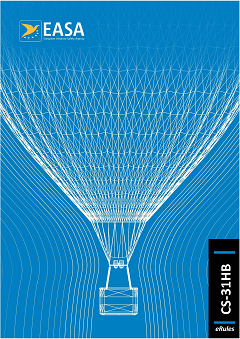CS 31TGB.12 Proof of compliance
ED Decision 2013/011/R
Each requirement of this Subpart is met at each mass and lift combination within the operating conditions for which certification is requested. This is shown by:
(a) Tests upon a balloon of the type for which certification is requested or by calculations based on, and equal in accuracy to, the results of testing; and
(b) Systematic investigation of each mass and lift combination if compliance cannot be reasonably inferred from the masses investigated.
ED Decision 2013/011/R
The range of masses over which the balloon may be safely operated is established and at least consists of:
(a) Maximum mass.
The maximum mass is the highest mass at which compliance with each applicable requirement of CS-31TGB is shown. The maximum mass is established so that it is not more than the least of:
(1) the maximum mass selected for the product; or
(2) the design maximum mass, which is the highest mass at which each structural loading condition is shown.
(b) Minimum mass:
The minimum mass is the lowest mass at which compliance with the structural loading requirement is shown for the tether system.
(c) Mass limitation information related to safe operation of the balloon are included in the Flight Manual. (See CS 31TGB.81(b)(2))
ED Decision 2013/011/R
Maximum mass
The maximum mass results in a weight force that is equal or lower to the maximum static lift force. The lift-producing medium is not part of the maximum mass.
For each structural loading case the maximum mass is established. The maximum mass consists of the balloon and the length of the tether cable, which weight force acts upon the balloon in the specific load case.
The maximum design mass of the product is the least of the maximum masses established for the load cases or a lower maximum mass if so selected by the applicant.
Minimum mass
The minimum mass is the mass that results in the highest loading in the tether system under the following conditions for which compliance to the structural requirements is shown:
Maximum deceleration during ascent
Maximum static lift
Maximal permissible wind speed of operation
Since the mass increases with the extension of the tether cable, the critical case for the minimum mass is reached at the beginning of the ascent.
Mass limitations and information, e.g. pay load are established from the maximum and minimum masses and provided in the Flight Manual.
ED Decision 2013/011/R
(a) The balloon is safely controllable and manoeuvrable without requiring exceptional skill. Associated operational limitations are established and included in the Flight Manual. (See CS 31TGB.81(b)(2))
(b) The continuing controllability of the balloon or other mitigations are provided to give each occupant every reasonable chance of escaping serious injury in the following emergency conditions:
(1) Potential or unintended free flight.
(2) Terminating operation in wind conditions exceeding the operating limitations by 50 %.
(3) Tether system failure that prevents descent from the maximum operating height or any other height if considered more critical.
AMC1 31TGB.20(b) Controllability
ED Decision 2013/011/R
It is established by analysis that the hazards from the specified emergency conditions are mitigated by design or procedures. Failure modes that can result in an unintended free flight of the balloon with occupants are included in this analysis.
A suitable device (e.g. electronic altitude pressure switch combined with an ascent velocity detector) ensuring that the envelope does not burst and a lifting gas valve is operated such that a descent occurs in a manageable manner is regarded as acceptable.
A suitable procedure describes all necessary measures to be taken for the recovery.
If procedures for these emergency conditions are not covered by the normal operating procedures they are included in the Flight Manual.
